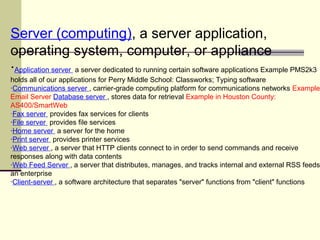Lan vs wan
- 1. Server (computing), a server application, operating system, computer, or appliance ·Application server a server dedicated to running certain software applications Example PMS2k3 holds all of our applications for Perry Middle School: Classworks; Typing software ·Communications server , carrier-grade computing platform for communications networks Example Email Server Database server , stores data for retrieval Example in Houston County: AS400/SmartWeb ·Fax server provides fax services for clients ·File server provides file services ·Home server a server for the home ·Print server provides printer services ·Web server , a server that HTTP clients connect to in order to send commands and receive responses along with data contents ·Web Feed Server , a server that distributes, manages, and tracks internal and external RSS feeds an enterprise ·Client-server , a software architecture that separates "server" functions from "client" functions
- 2. Protocol is a convention or standard that controls or enables the connection Internet protocol (IP)- Server assigns an IP address to each computer when it comes online. CANNOT connect to the Internet or LAN without an IP address.
- 3. A computer network is a group of interconnected computers and network printers. Router Switch
- 4. WAN- Wide Area Network is a computer network that covers a broad area (i.e., any network whose communications links cross metropolitan, regional, or national boundaries). Connects all LAN servers and all networked computers. Example: Houston County School System LAN- Local Area Network is a computer network covering a small geographic area, like a home, office, or group of buildings e.g. a school. Computers are connected to a server. Faster file acquisition due to small area. Example: Perry Middle School
- 5. ·The largest computer network in the world (a network of networks) ·Information exchange is seamless using open, non-proprietary standards and protocols, within interconnected networks ·A true democratic communications forum producing a democratization of information ·Spirit of information sharing and open access underlies the Internet.
- 6. ·Packets of information flow between machines governed by common rules (protocols): ·Internet is a packet-switching network ·Messages are decomposed into packets, containing part of the message, plus information on the sending and receiving machines and how the packet relates to the other packets ·Packets travel independently and possibly on different routes through the Internet ·Packets are reassembled into the message at the receiving machine.
- 7. HTTP- Hypertext Transfer Protocol is a URI scheme or network protocol for the transfer of information on the Internet. Its use for retrieving inter-linked text documents led to the establishment of the World Wide Web. HTTPS - Hypertext Transfer Protocol over Secure Socket Layer is a URI scheme used to indicate a secure HTTP connection. FTP- File Transfer Protocol is a URI scheme or network protocol used to transfer data from one computer to another through a network such as the Internet.
- 8. URI -Uniform Resource Identifier is the top level of the Uniform Resource Identifier. All URIs and absolute URI references are formed with a scheme name, followed by a colon character (":"). Example: http: URL - Uniform Resource Locator is an URI which also specifies where the identified resource is available and the protocol for retrieving it. It is a means of accessing a network location.







